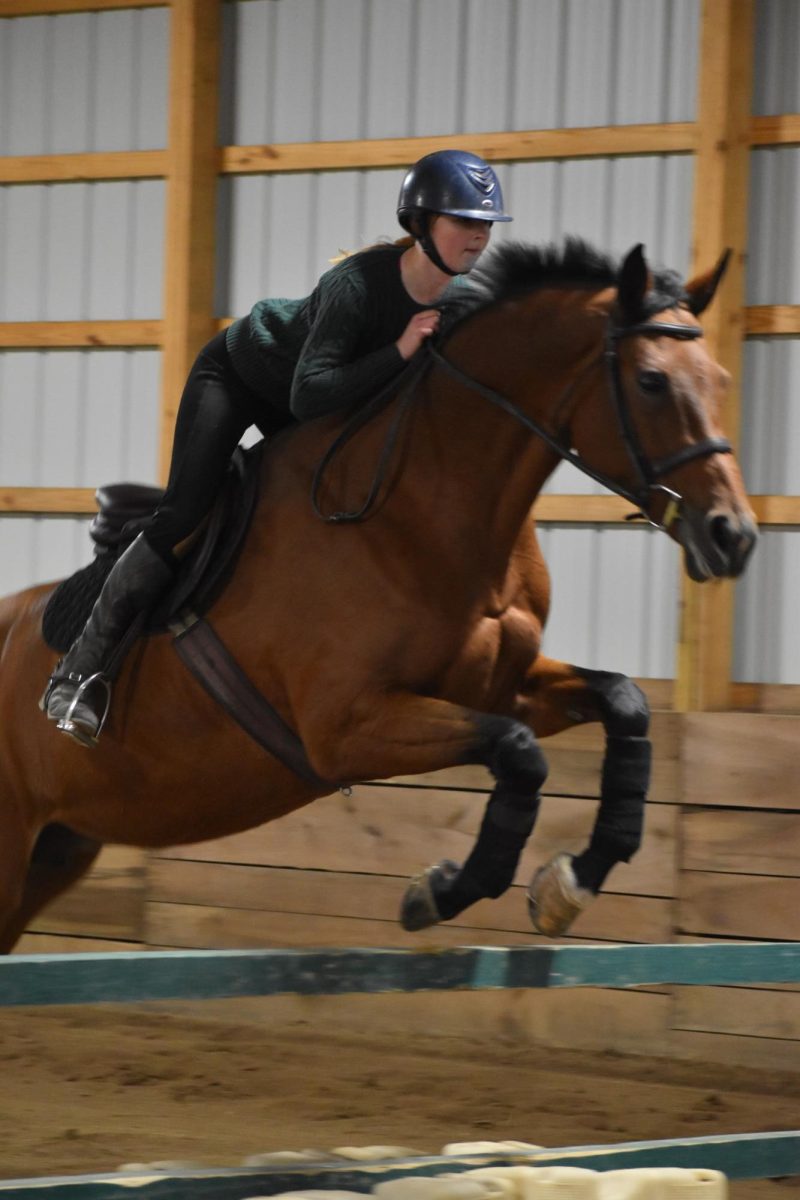Senior Jenna Griffin was in fifth grade, lying in bed asleep, when she wanted to go back and experience being on the cruise trip she had sailed over a holiday.
“I wanted to be there again, so I just manifested being in this particular area of the ship that (I) was on, and about five to ten minutes later I was there and roaming around, free,” she said, describing her dream that night.
According to psychology teacher Mickey O’Toole, this phenomenon of having awareness of or control over one’s dreams is known as “lucid dreaming.”

“Essentially it’s a dream that you are aware you are dreaming, and in some instances, because you’re aware, you can control it to some degree…(it’s) a dream where you’re aware you’re in the dream or currently dreaming,” he said.
Sophomore Lillian Zaharako said she heard of lucid dreaming on social media sites like Instagram and TikTok a few years ago and was immediately interested to try it out.
“I researched (lucid dreaming) a little more, and (I thought), ‘that’s attainable.’ It was actually hard (to learn how to do it) because I can’t sit still, and it’s hard for me to concentrate,” Zaharako said.
O’Toole said as a relatively less-researched subject, sleep studies about lucid dreaming were few and far in between. The studies that do exist show a strong correlation between lucid dreaming and dreaming which normally takes place during the Rapid Eye Movement (REM) portion of one’s sleep cycle. He said some studies have tried to put participants back into REM sleep quicker when they wake up to see if it would induce lucid dreaming.
O’Toole said there are several methods to start lucid dreaming. He said one such method used by researchers to prompt lucid dreaming in studies is to have participants perform a mundane task, which will then likely be repeated in the dream. Performing the task in the dream may alert the person that they are in a dream.
“If you’re trying to read in your dream, it may not be in a language you understand, the words may fall off the pages,” O’Toole said. “Or with jumping, you don’t feel yourself being pulled back down by gravity; you kind of either float down, or you don’t even feel impact with the earth when you hit it, and at that moment you may now realize you’re dreaming.”
Zaharako said her process in learning how to lucid dream was a complicated one.
“I told myself that I would practice (lucid dreaming) every single night, but that obviously didn’t work,” she said. “I think the hardest part was that it was really time consuming, because you’re just laying there and trying to concentrate… and I’m pretty impatient with stuff like that.”
Griffin said while it was initially a complex task, she can now lucid dream without investing too much effort.
“I can be like, ‘I want to lucid dream’ and I do that falling sensation and I’m where I need to be,” she said.
Zaharako said she followed instructions that can be frequently seen in blog posts that instruct one on how to lucid dream, and the key point she said she noticed was to concentrate and focus on the details of the dream, which is how she said she tries to go into lucid dreaming.
The benefits of lucid dreaming, though, are minimal if they do exist at all.
Griffin and Zaharako both said they did not notice any marked improvements in their performance in either school or work due to lucid dreaming.
Griffin said although it helped her when she had a bad day, lucid dreaming did not increase her productivity in any way.

“If it was a stressful day, I could go to the beach or something, and just dream about the ocean,” Griffin said.
Griffin also said lucid dreaming is good for overcoming fears by confronting them in dreams and desensitizing oneself to them to decrease any adverse reactions.
Zaharako said beyond improving her mood and making her feel better, she also did not notice any improvements in her work but said if she looked into them, she could most likely see an improvement.
“If I logged (data about my work) for a while and took research into it, I’d be willing to bet on (lucid dreaming increasing productivity levels. (But) from what I can see currently, I don’t see a ton of correlation,” she said.
Due to the time-consuming nature of lucid dreaming, Zaharako said she lucid dreamed once every two to three weeks, but Griffin said she had a different take on the frequency of lucid dreaming.
“Obviously, I rarely do it because it can lead to some negative mental health effects, and I don’t want that to happen to me, so I rarely do it anymore,” she said.
According to research from NCBI, frequent lucid dreaming can cause a loss of sleep and blur the lines between reality and dreams. The paper says lucid dreaming is dangerous for people already dealing with hallucinatory symptoms as they may see an increase in their psychosis and hallucinations due to frequent lucid dreaming.
Zaharako said she sometimes off-handedly wonders if everything she is looking at is a lucid dream.
Griffin and Zaharako also said they felt a little disappointment each time they woke up from lucid dreaming at the thought of having to leave behind a world of their own making and control.
“I wake up and I’m like, ‘Oh yeah, it’s time for another regular day’… just waking and being up like, none of that was reality,” Griffin said.
Zaharako said although she is disappointed when she wakes up, she comforts herself by thinking about being able to dream that specific dream once more and relive the experience.
Griffin said overall although lucid dreaming can have positive effects on one’s mood and help in confronting fears, it is best practice to not make lucid dreaming a habit to ensure that the line between reality and dreams does not get blurred.
O’Toole agreed, saying, “You (can) lose a sense of reality because you might think you’re back in the dream.”


































![British royalty are American celebrities [opinion]](https://hilite.org/wp-content/uploads/2024/03/Screenshot-2024-03-24-1.44.57-PM.png)



















![Chelsea Meng on her instagram-run bracelet shop [Biz Buzz]](https://hilite.org/wp-content/uploads/2024/04/IMG_2446-1200x838.jpg)
![Review: Quiet on Set: The Dark Side of Kids TV is the long awaited exposé of pedophilia within the children’s entertainment industry [MUSE]](https://hilite.org/wp-content/uploads/2024/04/unnamed.jpg)
![Review: “The Iron Claw” cannot get enough praise [MUSE]](https://hilite.org/wp-content/uploads/2024/04/unnamed.png)
![Review: “The Bear” sets an unbelievably high bar for future comedy shows [MUSE]](https://hilite.org/wp-content/uploads/2024/03/unnamed.png)
![Review: “Mysterious Lotus Casebook” is an amazing historical Chinese drama [MUSE]](https://hilite.org/wp-content/uploads/2024/03/0.webp)
![Review in Print: Maripaz Villar brings a delightfully unique style to the world of WEBTOON [MUSE]](https://hilite.org/wp-content/uploads/2023/12/maripazcover-1200x960.jpg)
![Review: “The Sword of Kaigen” is a masterpiece [MUSE]](https://hilite.org/wp-content/uploads/2023/11/Screenshot-2023-11-26-201051.png)
![Review: Gateron Oil Kings, great linear switches, okay price [MUSE]](https://hilite.org/wp-content/uploads/2023/11/Screenshot-2023-11-26-200553.png)
![Review: “A Haunting in Venice” is a significant improvement from other Agatha Christie adaptations [MUSE]](https://hilite.org/wp-content/uploads/2023/11/e7ee2938a6d422669771bce6d8088521.jpg)
![Review: A Thanksgiving story from elementary school, still just as interesting [MUSE]](https://hilite.org/wp-content/uploads/2023/11/Screenshot-2023-11-26-195514-987x1200.png)
![Review: When I Fly Towards You, cute, uplifting youth drama [MUSE]](https://hilite.org/wp-content/uploads/2023/09/When-I-Fly-Towards-You-Chinese-drama.png)
![Postcards from Muse: Hawaii Travel Diary [MUSE]](https://hilite.org/wp-content/uploads/2023/09/My-project-1-1200x1200.jpg)
![Review: Ladybug & Cat Noir: The Movie, departure from original show [MUSE]](https://hilite.org/wp-content/uploads/2023/09/Ladybug__Cat_Noir_-_The_Movie_poster.jpg)
![Review in Print: Hidden Love is the cute, uplifting drama everyone needs [MUSE]](https://hilite.org/wp-content/uploads/2023/09/hiddenlovecover-e1693597208225-1030x1200.png)
![Review in Print: Heartstopper is the heartwarming queer romance we all need [MUSE]](https://hilite.org/wp-content/uploads/2023/08/museheartstoppercover-1200x654.png)






















![Review: Ladybug & Cat Noir: The Movie, departure from original show [MUSE]](https://hilite.org/wp-content/uploads/2023/09/Ladybug__Cat_Noir_-_The_Movie_poster-221x300.jpg)

![Review: Next in Fashion season two survives changes, becomes a valuable pop culture artifact [MUSE]](https://hilite.org/wp-content/uploads/2023/03/Screen-Shot-2023-03-09-at-11.05.05-AM-300x214.png)
![Review: Is The Stormlight Archive worth it? [MUSE]](https://hilite.org/wp-content/uploads/2023/10/unnamed-1-184x300.png)

